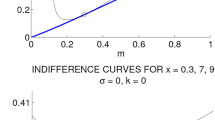Abstract
When insurance firms can monitor with non-prohibitive costs the consumption of risk-influencing goods by an insured, they have incentives to tax-subsidize the insured's consumption of the goods. If the government cannot monitor at a lower cost than private insurers, intervention is neither needed nor desirable. Where the government does have a monitoring-cost advantage, it cannot achieve a constrained optimum by commodity tax-subsidies alone. It must also augment the level of insurance and, in some cases, prohibit private tax-subsidies by insurers. Such “invasive” intervention can be avoided if the government regulates the consumption of the risk-influencing goods.
Similar content being viewed by others
References
Arnott, Richard, and Joseph Stiglitz. (1986). “Moral Hazard and Optimal Commodity Taxation,” Journal of Public Economics 29, 1–24.
Arnott, Richard, and Joseph Stiglitz. (1988). “The Basic Analytics of Moral Hazard,” Scandinavian Journal of Economics 90 (3), 383–413.
Bruce, Neil, and Kar-yiu Wong. (1991). “Moral Hazard, Private Provison of Insurance, and Government Intervention,” Discussion Paper Series 91-2, Institute for Economic Research, University of Washington.
Dixit, Avinash. (1987). “Trade and Insurance with Moral Hazard,” Journal of International Economics 23, 201–220.
Guesnerie, R. and K. Roberts. (1984). “Effective Policy Tools and Quantity Controls,” Econometrica 52, 59–86.
Greenwald, Bruce, and Joseph Stiglitz. (1986). “Externalities in Economies with Imperfect Information and Incomplete Markets,” Quarterly Journal of Economics 101 (2), 229–264.
Helpman, Elhanan, and Jean-Jacques Laffont. (1975). “On Moral Hazard in General Equilibrium Theory,” Journal of Economic Theory 10, 8–23.
Kaplow, Louis. (1991). “Incentives and Government Relif for Risk,” Journal of Risk and Uncertainty 4, 167–175.
Kahn, Charles M., and Dilip Mookherjee. (1991). “Efficiency of Markets under Moral Hazard with Side-Trading.” Mimeo.
Pauly, Mark V. (1968). “The Economics of Moral Hazard: Comment,” American Economic Review 58 (3), 531–536.
Pauly, Mark V. (1974). “Overprovision and Public Provision of Insurance,” Quarterly Journal of Economics 88, 44–61.
Prescott, Edward C., and Robert M. Townsend. (1984). “Pareto Optima and Competitive Equilibria With Adverse Selection and Moral Hazard,” Econometrica 52 (1), 21–45.
Shavell, Steven. (1979). “On Moral Hazard and Insurance,” Quarterly Journal of Economics 94 (4), 541–562.
Author information
Authors and Affiliations
Rights and permissions
About this article
Cite this article
Bruce, N., Wong, KY. Moral hazard, monitoring costs, and optimal government intervention. Journal of Risk and Uncertainty 12, 77–90 (1996). https://doi.org/10.1007/BF00353332
Issue Date:
DOI: https://doi.org/10.1007/BF00353332




